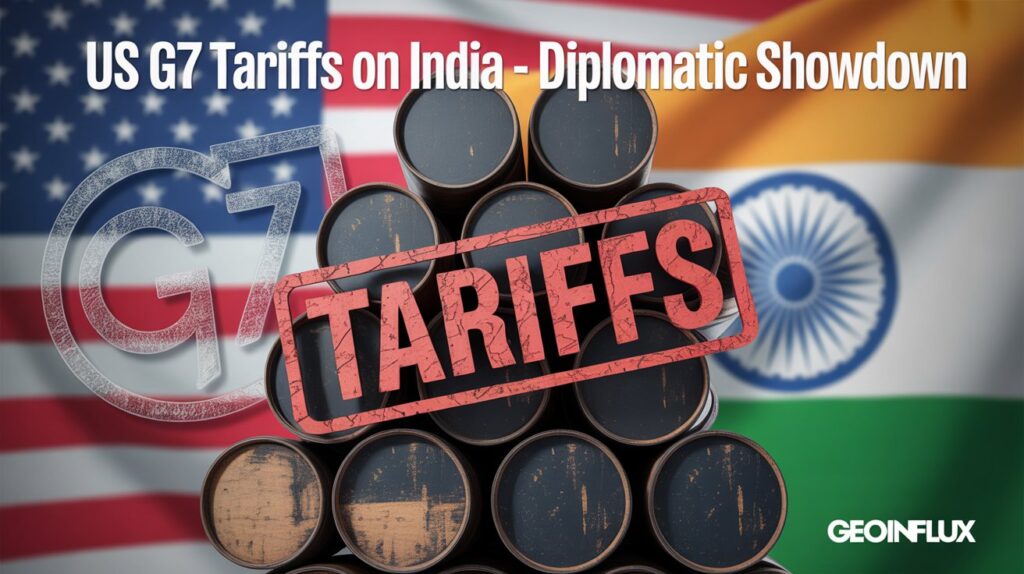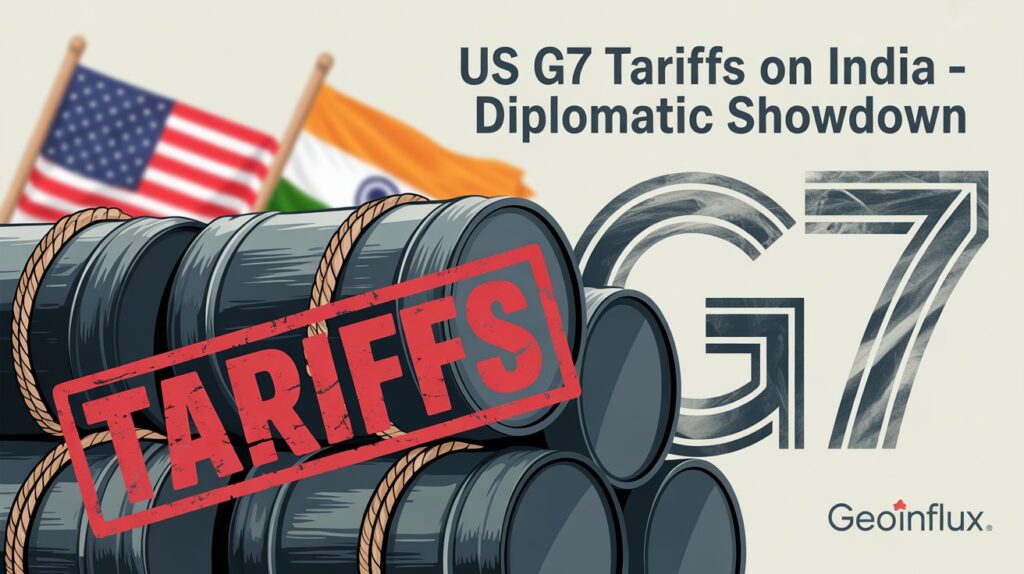US G7 tariffs on India over Russian oil imports are sparking a diplomatic showdown. Explore the economic fallout, trade disputes, and India’s oil security policy in 2025.
US G7 Tariffs on India and China Over Russian Oil – What’s at Stake
The debate over US G7 tariffs on India has erupted into a high-stakes diplomatic standoff. Washington is urging its G7 allies to impose punitive tariffs on both India and China for continuing large-scale oil imports from Russia.
While China often dominates headlines, the real pressure is now on India—one of the fastest-growing economies that has strategically deepened energy ties with Moscow since the Ukraine war. The push for tariffs threatens to escalate into a broader US India trade dispute 2025, raising questions about energy security, sanctions enforcement, and global economic stability.

Background: Why US G7 Tariffs on India Are Being Pushed Amid Russian Oil Disputes
Calls for US G7 tariffs on India gained momentum after Washington-based economist Scott Bessent suggested that tariffs could cut Russia’s war funding by targeting its biggest energy clients. The G7 sanctions regime has struggled to cap Russian oil prices, and India’s discounted imports from Moscow have become a focal point of Western frustration.
For Washington, the logic is simple: by penalizing India, it could deter Moscow’s revenue stream. For New Delhi, the issue is far more complex. Cheap Russian oil has underpinned India’s oil security policy 2025, shielding its economy from inflation and ensuring steady growth. Tariffs would not only disrupt this strategy but also spark fresh tensions in India US relations, already strained by trade disputes and technology restrictions.
Washington’s Proposal: How US G7 Tariffs on India and China Aim to Curb Russian Oil Imports
The US G7 tariff proposal frames India and China as “enablers” of Russia’s economy. By importing millions of barrels of crude, they effectively dilute Western sanctions. According to leaked reports, Washington has floated the idea of 25%–30% tariffs on Indian and Chinese exports to G7 nations if they continue to import beyond agreed thresholds.
- Target countries: India and China
- Main issue: Russian oil purchases
- Proposed action: Tariffs on exports to G7 markets
- US argument: Stop “backdoor financing” of Russia
Although the plan is still under discussion, insiders suggest that the US hopes to present a united G7 front at the next summit. However, divisions within the bloc—particularly from Germany, Italy, and Japan—may complicate Washington’s push.
India’s Response: Defending Oil Security Policy Against US G7 Tariffs
India has categorically defended its position, arguing that US G7 tariffs on India would be both unfair and counterproductive. Officials stress that India’s oil security policy 2025 is rooted in affordability, diversification, and sovereignty.
Indian policymakers have highlighted three main points:
- Economic survival – Tariffs would raise energy prices domestically and trigger inflation across emerging markets.
- Geopolitical autonomy – India refuses to be boxed into Western sanctions regimes at the cost of its national interest.
- Strategic leverage – New Delhi has maintained that its engagement with Russia balances China’s dominance in Eurasia.
Foreign Minister S. Jaishankar recently stated that India will not “play by externally imposed rules” when it comes to critical resources like energy.
Economic Fallout: US G7 Tariffs on India and the Risk of a New US India Trade Dispute 2025
If implemented, US G7 tariffs on India could spark one of the most significant US India trade disputes in 2025. Analysts warn of a chain reaction:
- Export losses: Indian goods, from textiles to IT services, could face tariff hikes in G7 markets.
- Retaliatory measures: India may impose counter-tariffs on US and European products.
- Investor uncertainty: Markets could react negatively, reducing FDI inflows.
- Global oil shock: Restricting India’s Russian imports may drive up prices worldwide.
For India, the stakes are massive. As the world’s third-largest oil consumer, any disruption risks undermining growth projections and destabilizing supply chains.
Geopolitical Repercussions: G7 Sanctions, India Russia Oil Imports, and China’s Role
While US G7 tariffs on India are at the center of the debate, China remains a silent yet critical player. Beijing has been importing even larger quantities of Russian crude, but Washington views India as more diplomatically “pliable.” This selective targeting has raised accusations of double standards within the G7 framework.
At the same time:
- Russia gains: Moscow continues to find steady buyers in Asia.
- India adjusts: New Delhi has explored payment settlements in rupees and yuan to bypass Western restrictions.
- China’s buffer: Beijing benefits from India taking the heat, deflecting some Western scrutiny.
This dynamic reinforces the idea that the G7’s pressure may have more to do with geopolitics than pure economics.
Strategic Analysis: Can India Navigate US G7 Tariffs Without Sacrificing Energy Security?
India now faces a difficult balancing act. On one side, it risks US G7 tariffs on India and potential economic sanctions 2025. On the other, stepping back from Russian oil imports could jeopardize its growth and make it overly dependent on Middle Eastern supplies.
Strategic options include:
- Diversification – Expanding imports from Africa, the US, and Latin America.
- Diplomatic leverage – Using forums like BRICS and SCO to counter G7 pressure.
- Bilateral bargaining – Negotiating exemptions with the US in exchange for security or technology cooperation.
- Energy transition – Accelerating renewable energy investments to reduce dependency.
India’s ability to maneuver will determine whether this standoff becomes a short-lived trade skirmish or a long-term strategic rupture.
Conclusion: US G7 Tariffs on India – A Diplomatic Showdown With Global Implications
The push for US G7 tariffs on India is more than an economic measure—it’s a test of global multipolarity. By targeting New Delhi’s Russia oil imports, Washington risks alienating a key partner in Asia while inadvertently strengthening India’s ties with Moscow and Beijing.
For India, the path forward will require a mix of defiance, diplomacy, and diversification. Whether this dispute escalates into a full-blown US India trade war in 2025 or settles into compromise, the outcome will reshape the global energy and trade order for years to come.
Recap Table: Key Takeaways on US G7 Tariffs on India
| Aspect | Details |
|---|---|
| Main Issue | Russian oil imports by India and China |
| US Proposal | Impose tariffs on Indian/Chinese exports to G7 |
| India’s Stand | Energy security and sovereignty |
| Economic Risk | Inflation, trade war, FDI uncertainty |
| Geopolitical Impact | Strained India-US ties, stronger Russia-India link |
| Strategic Options | Diversification, diplomacy, renewable energy |
FAQs on US G7 Tariffs on India, Russian Oil, and Global Trade
1. Why are US G7 tariffs on India being proposed in 2025?
US G7 tariffs on India are being proposed because Washington believes New Delhi’s Russian oil imports undermine Western sanctions on Moscow. The US argues that tariffs would discourage India from buying discounted Russian crude and weaken Russia’s war chest. However, India views this as an external imposition that threatens its oil security policy 2025 and could destabilize its economy.
2. How would US G7 tariffs on India affect its economy?
Tariffs could raise the cost of Indian exports to G7 countries, reduce competitiveness, and trigger retaliatory duties. Inflation may rise as oil imports face disruption, while investor confidence could decline. Analysts warn that a US India trade dispute 2025 could shave off growth rates and complicate supply chains.
3. What role does Russian oil play in India’s energy strategy?
Russian oil is vital to India’s energy security because it is cheaper and available in large volumes. Since the Ukraine conflict, India has ramped up imports, often paying in rupees or alternative currencies to bypass sanctions. This strategy allows India to shield consumers from price shocks and maintain economic stability, making it reluctant to comply with Western restrictions.
4. Are G7 countries united on imposing tariffs on India?
Not entirely. While the US is pushing strongly, European nations like Germany and Italy are cautious. They fear a tariff regime could trigger global market instability and undermine ties with India, an important trade partner. Japan, too, has reservations due to its reliance on Asian supply chains. This lack of unity may delay or dilute the tariff plan.
5. Could US G7 tariffs on India push New Delhi closer to Russia and China?
Yes. If Washington insists on tariffs, India may deepen its strategic partnerships with Russia and China through BRICS, SCO, and other forums. This shift could accelerate the trend toward a multipolar world order, where India seeks to balance Western alliances with Eurasian cooperation.
Related Articles on GeoInflux
- India–Russia Trade in a Sanctioned World: Strategic Energy Deals Redefine Ties
- India and the QUAD: Balancing China Without Burning Bridges
- Doval Jaishankar Russia Visit: Energy, Defense, and US Pressure
References
- US urges G7 to impose tariffs on India, China over Russian oil – NDTV
- US presses G7 countries to target India, China over Russian oil imports – Indian Express
- G7 finance ministers discuss tariffs, possible sanctions to increase pressure on Russia – India Today
- US appeals for more tariffs over Russian oil amid turnaround of ties with India – Hindustan Times
- US calls on G7, EU to impose tariffs on China, India over Russian oil purchases – Reuters
- US Treasury Secretary urges G7 and EU to impose tariffs on Indian, Chinese goods tied to Russian oil – Economic Times
- G7 finance ministers weigh sanctions on countries supporting Russia’s war effort – CNBC TV18






It is really a great and useful piece of info. I’m glad that you shared this helpful info with us. Please keep us informed like this. Thanks for sharing.